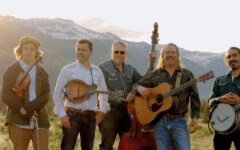
Spanish banjo master Lluis Gomez was one of the participants in last month’s CBA Jam-A-Thon, a 48 hour, online bluegrass festival held to raise funds for the California Bluegrass Association’s Youth Academy. The organizers sent out request to musicians all over the world seeking artists who could record hour long sets, which were streamed January 8-10 on Facebook and YouTube.
The Jam-A-Thon was a smashing success, bringing in a substantial take which be a huge assistance in the CBA’s educational efforts.
Gomez shared a couple of snippets from the performance he contributed, with Carol Duran on fiddle and Maribel Rivero on bass, along with his comments about being a part of Jam-A-Thon, and his current interest in playing Spanish music on bluegrass instruments.
Over the years, some of my American and European banjo pals kept saying to me that I should work on music from my country. I specifically remember two years ago talking with Martino Coppo backstage at the La Roche Bluegrass Festival in France: he really encouraged me to play Spanish and Catalan music. But, as usual, I was busy with projects, playing, etc… With the lockdown, though, something happened. Of course, there were no gigs and no touring, so I had more time to be at home and think about things.
Sometimes it seems that all signs point in the same direction. For example, I’m working on a new book for Mel Bay, a series of tunes for mandolin, guitar, etc. It’s called Early Music Gems, and the repertoire is really influenced by classical guitar, some anonymous composers, and others like Gaspar Sanz, John Playford, Michael Praetorious, and Susato. Some of the tunes are really flamenco, so, voilà!, a sign!
Then another sign appeared with my participation at the Jam-A-Thon organized by the CBA (California Bluegrass Organization). Christopher Williams from La Roche contacted me and asked if I would like to participate in the streaming event, and of course I said yes!
The idea was for a 48 hours non-stop program of live streaming, January 8-10, to the whole world. The event, led by CBA Youth Academy director Kimber Ludiker, raised $25,000 in donations, to be split between the artists and an effort to build a new educational website for children interested in bluegrass. More than 100 musicians from 12 countries; awesome, right?!
So, I needed to prepare a one hour show, and I was thinking I wanted to offer something different, so I asked Carol Duran and Maribel Rivero to participate. They agreed, and after thinking about the repertoire, we decided on mostly original tunes with a special emphasis on Spanish and Catalan material.
I have to thank Kimber Ludiker for organizing such an amazing event. It was a great weekend with plenty of music and friends. To be honest, it was something I needed during these hard days everyone is living all around the world!
So here are two tunes from the show, it was my first streaming show, and I have to thank Oriol Forn for all of his help with the video and audio.
Quan s’Atura el Temps
Carol Duran, well known fiddler, singer, and now director of the CAT (Centre Artesà Tradicionarius, a place to promote folk music from Catalonia and elsewhere), wrote this song during the lockdown. She sings in Catalan and talks about feelings from the confinement. The music is rooted in flamenco traditions. The translation of the title would be something like “When Times Stops.”
The tune is based on a flamenco mode, and with chords from the Spanish cadence, really cool to improvise on and a handicap for the banjo, especially when you have to follow the Carol, with lots of extra beats.
La Dama d’Aragó
Maribel Rivero sings a traditional Catalan song called La dama d’Aragó. This is a really well know song that talks about a beautiful woman who is the daughter of the French king.
It’s a really interesting song in Am with some extra beats, and the goal for a banjo player is to play slow. I play an introduction of the melody harmonizing the melody with chords.
Both songs are a handicap for a banjo player, minor sounds and a slow tempo, but I think it works really well and provides a new direction to experiment with the banjo.
Right now I’m studying a lot of Spanish roots music and trying to play it on the banjo. Every Saturday I have a Zoom meeting with some American banjo players, maybe the only thing we can do in the pandemic situation, because in normal life all of us we were playing and touring. Each one of us shares banjo ideas, and of course I share flamenco!
So here is a new goal for me as a banjo player and a new project that I’m really happy about. The name? For the CBA show we jokingly called ourselves Las Chulas de California — difficult to translate to English, but something like “The Funny Girls from California!”
Stay safe, healthy, keep playing and Ole!!!”







